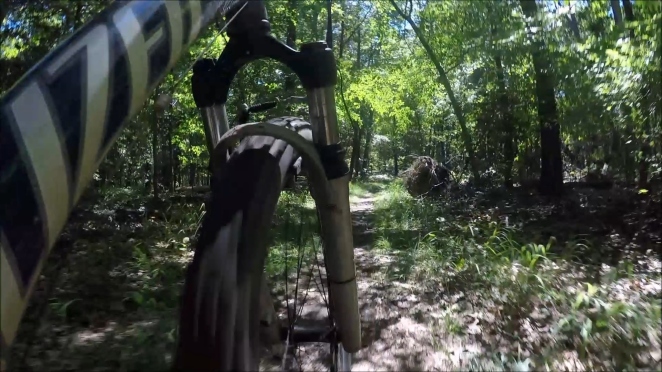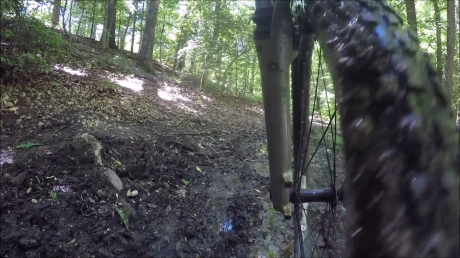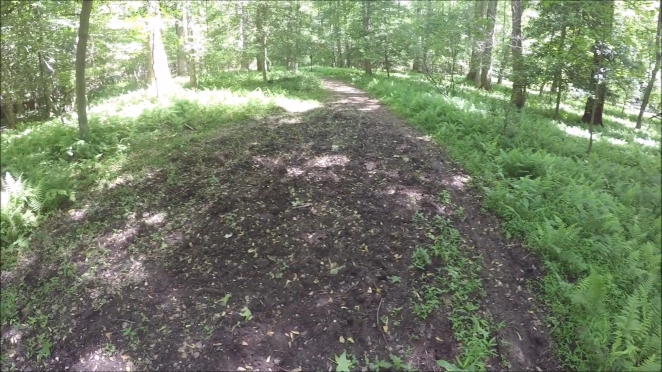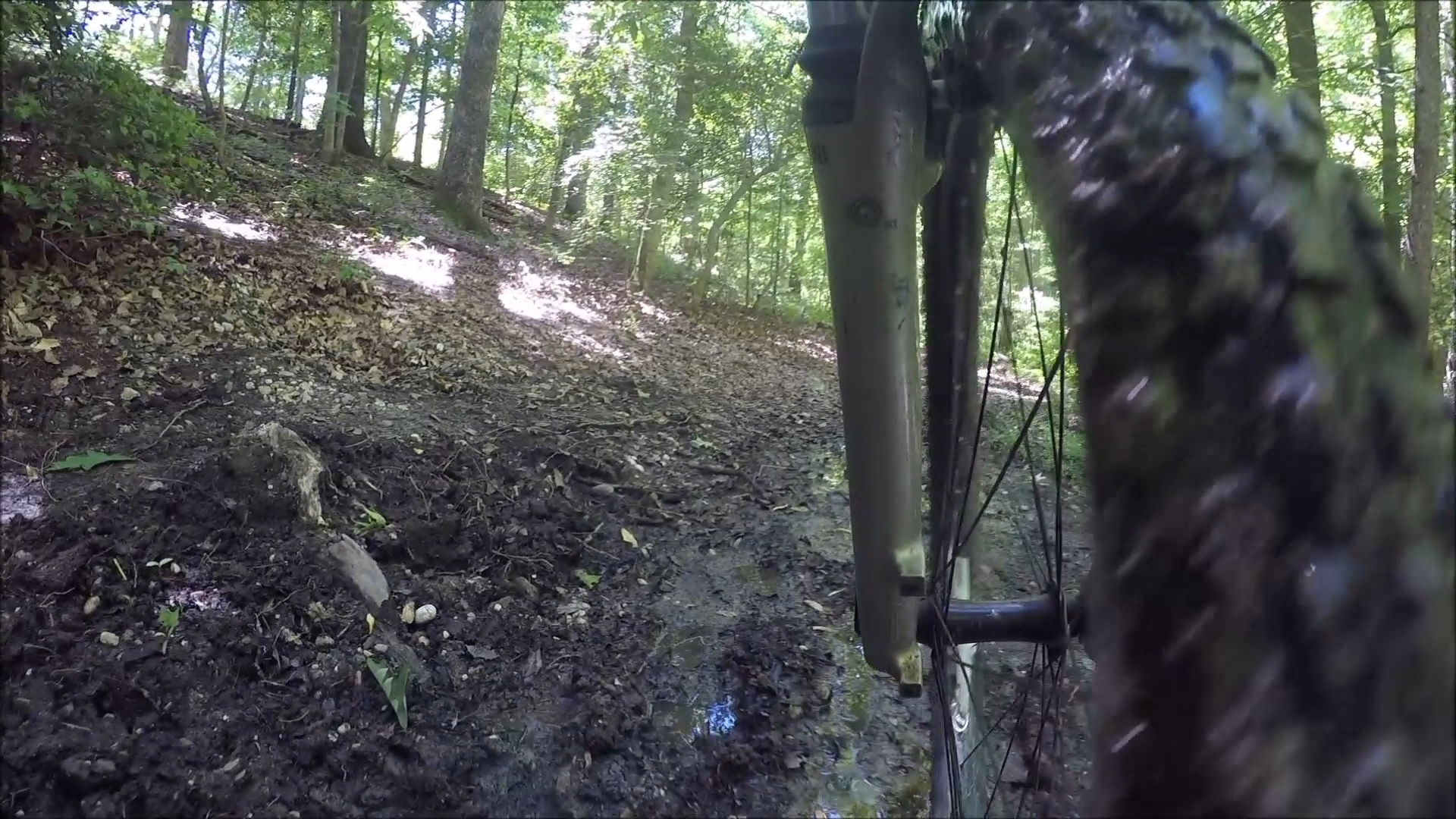I really enjoy trail-riding on my mountain bike (an old Specialized Rock Hopper). At the same time, I hate what mountain bikes do to some of my favorite trails. It’s a conundrum, forcing a little bit of self-examination and recognition of hypocrisy that I haven’t figured out how to resolve.
To be clear, I’m not talking about mountain bike paths that are built mostly as a gravity-mitigation exercise, where you go screaming down the periphery of a ski slope in summer and never pedal. I’m talking about trail riding – many, many trails are now designated as “multi-use”, for hikers, bikers, and horseback riders, so you can ride your bike on your favorite woodland circuit.
The problem is, in a nutshell — bikes tear up the place.
 Generally, the joy in biking a trail has to do with the technical skill of doing it without going over your handlebars. You’re moving too fast to appreciate wildlife and small-scale scenery (typically), and you’re focused on staying upright – hopping rocks, roots, traversing through creeks, etc. It’s that endless stream of quick adjustments while focusing on the next obstacle that makes trail riding exciting and fun. But the speed, mass, and forces of a bike and rider just can’t help but alter the terrain in a way that hikers, and even horses, don’t.
Generally, the joy in biking a trail has to do with the technical skill of doing it without going over your handlebars. You’re moving too fast to appreciate wildlife and small-scale scenery (typically), and you’re focused on staying upright – hopping rocks, roots, traversing through creeks, etc. It’s that endless stream of quick adjustments while focusing on the next obstacle that makes trail riding exciting and fun. But the speed, mass, and forces of a bike and rider just can’t help but alter the terrain in a way that hikers, and even horses, don’t.
 Turns start to become naturally banked as bikes push soil to the outside of the curve. Low spots collect water and turn into absolute mud holes as bikes plow through and throw mud and dirt everywhere (at least, this is true here in the wet eastern US, where I live). And then, the worst – both hikers and bikers start trying to avoid the worst of the mud by going around it (horses don’t seem to care), widening the trail, cutting new paths through higher ground to either side, around and through trees, trampling shrubs – until the narrow single-track trail swells to contain a swamp 20 feet wide, side-to-side, or more.
Turns start to become naturally banked as bikes push soil to the outside of the curve. Low spots collect water and turn into absolute mud holes as bikes plow through and throw mud and dirt everywhere (at least, this is true here in the wet eastern US, where I live). And then, the worst – both hikers and bikers start trying to avoid the worst of the mud by going around it (horses don’t seem to care), widening the trail, cutting new paths through higher ground to either side, around and through trees, trampling shrubs – until the narrow single-track trail swells to contain a swamp 20 feet wide, side-to-side, or more.
Trail maintainers address this by laying down planking to make something of a corduroy road, perhaps building a boardwalk, perhaps just throwing down a half-ton of gravel – anything to give structural support and foundation for travelers that gets them above the muck. While all these solutions work, the result is that you’re not on a trail any more, but a primitive road built through the woods. It’s all man-made, of course, but a trail, ironically, is built to focus human impact into a certain place and protect others. Bikes tend to expand that impact significantly.
There’s an aesthetic difference here. Rail trails – those old railroad rights of way that have been reclaimed for biking and hiking – are generally very bike-friendly, because they’re level, graded, typically straight for miles, and more often than not, paved. They are in fact GREAT for bikes, but while you can hike them, I have yet to meet the hiker who prefers walking along a road, even a narrow 3-foot rail bed, to a winding unpaved trail.

A typical section of trail that furrow-digging bikes have transformed into a wide, now dry scar. Narrow trails focus user impact into specific locations, but bikes tend to turn those trails into wide roads.
So, the problem I see here is that by inviting bikes onto hiking trails, it’s inevitable that you turn part of those trails into the roads that hikers, and land-use managers, were trying to avoid in the first place – and before you know it, the hikers become frustrated with dodging mud holes filled with bike tracks, and they go elsewhere, preferring a different experience. The natural areas become a little too man-made, and the low-impact trails have become significant scars on the landscape.
I happen to like both – and I’ve hiked and biked the same trails on numerous occasions. And I’ve CAUGHT myself on a bike, doing exactly what frustrates me as a hiker, widening the muck to avoid the deepest, grabbiest mud. And while I enjoy biking rail-trails, that journey misses some of the technical challenge of root-hopping, and just isn’t the same.
So… how can we accommodate trail-riding in a sustainable way? Can bikes and hikers (and horses) truly co-exist? And can trails survive bikes without making the transition to corduroy or gravel roads? I’d love to hear your thoughts.
Get Out There
Troy
http://www.flying-squirrel.org

Thanks for bringing up the conundrum. I think it is important that hikers have peaceful and safe venues free of the impacts of bikes. Ruts and erosions cause my footing and balance to be shaky. I am 72 and active but need poles to ‘feel my way’ in places. Then there is the problem of speeding bikes forcing me to step aside, or jump out of the way since I don’t hear as well as I used to.
I don’t really like the shared trails concept.
LikeLiked by 1 person
I was reluctant to even broach the topic of bikes flying around a corner into an unsuspecting hiker – but that’s certainly valid too. I tend to agree that bike trails and walking trails should be distinct. That still leaves us with the problem of bike trails being subject to significantly more erosion and impact, but I guess it’s a case of expectation management. I certainly don’t think of bikes and ATVs in the same category, but the scars they leave aren’t that much different.
LikeLike
I am right there with you on the conundrum, I like both and do not like the same things. ATVs are so bad that for the most part they have designated tracks. Biking looses the technical aspects of the ‘sport’ when one repeats the same trail too often;
I bike a rail trail with walkers and runners quite often. I do it for the exercise. I also walk the some trail with friends occasionally and I must say, those bikers are annoying as hell. War Eagle
LikeLike